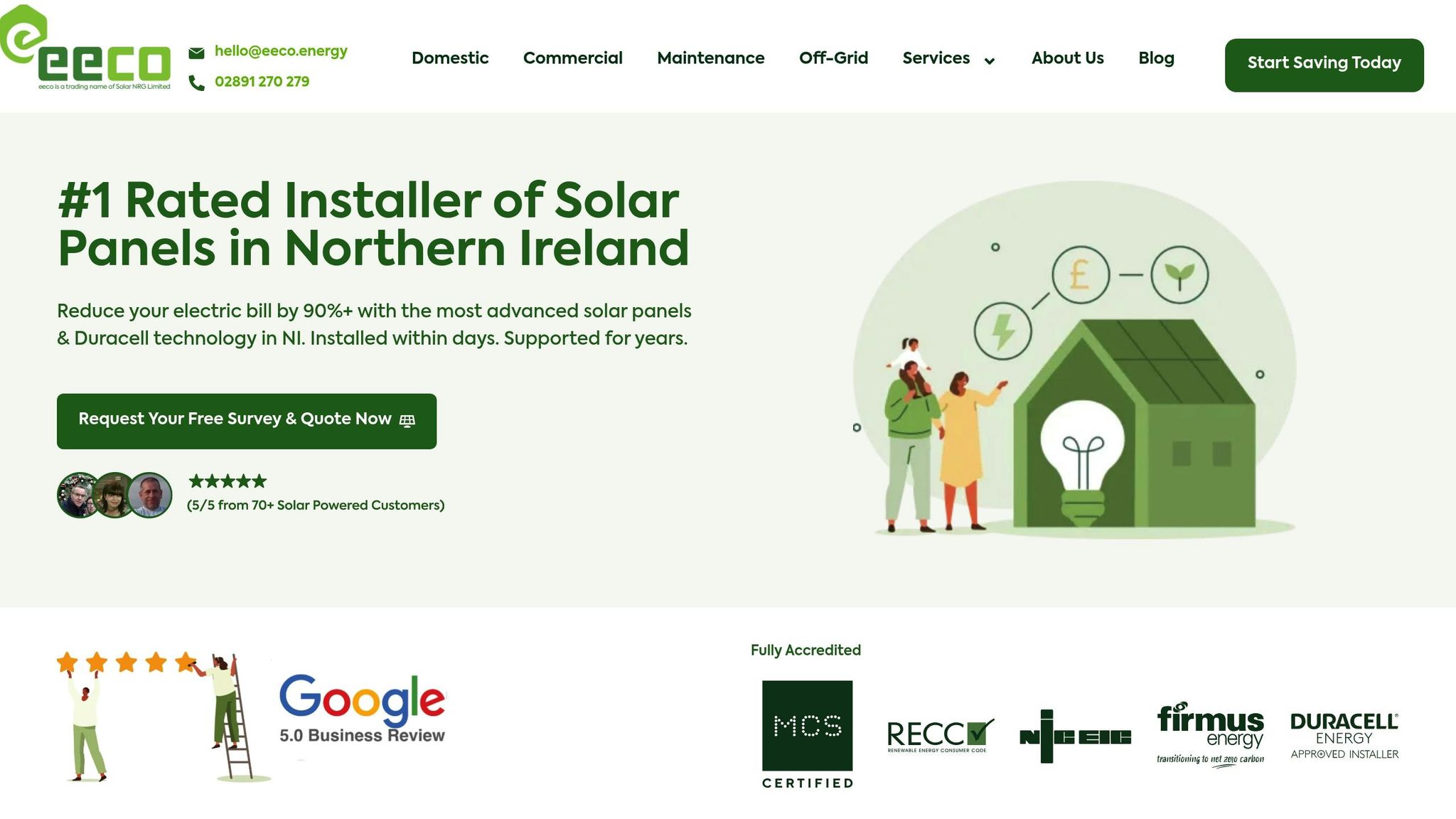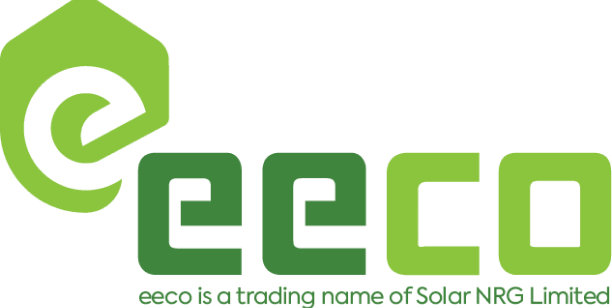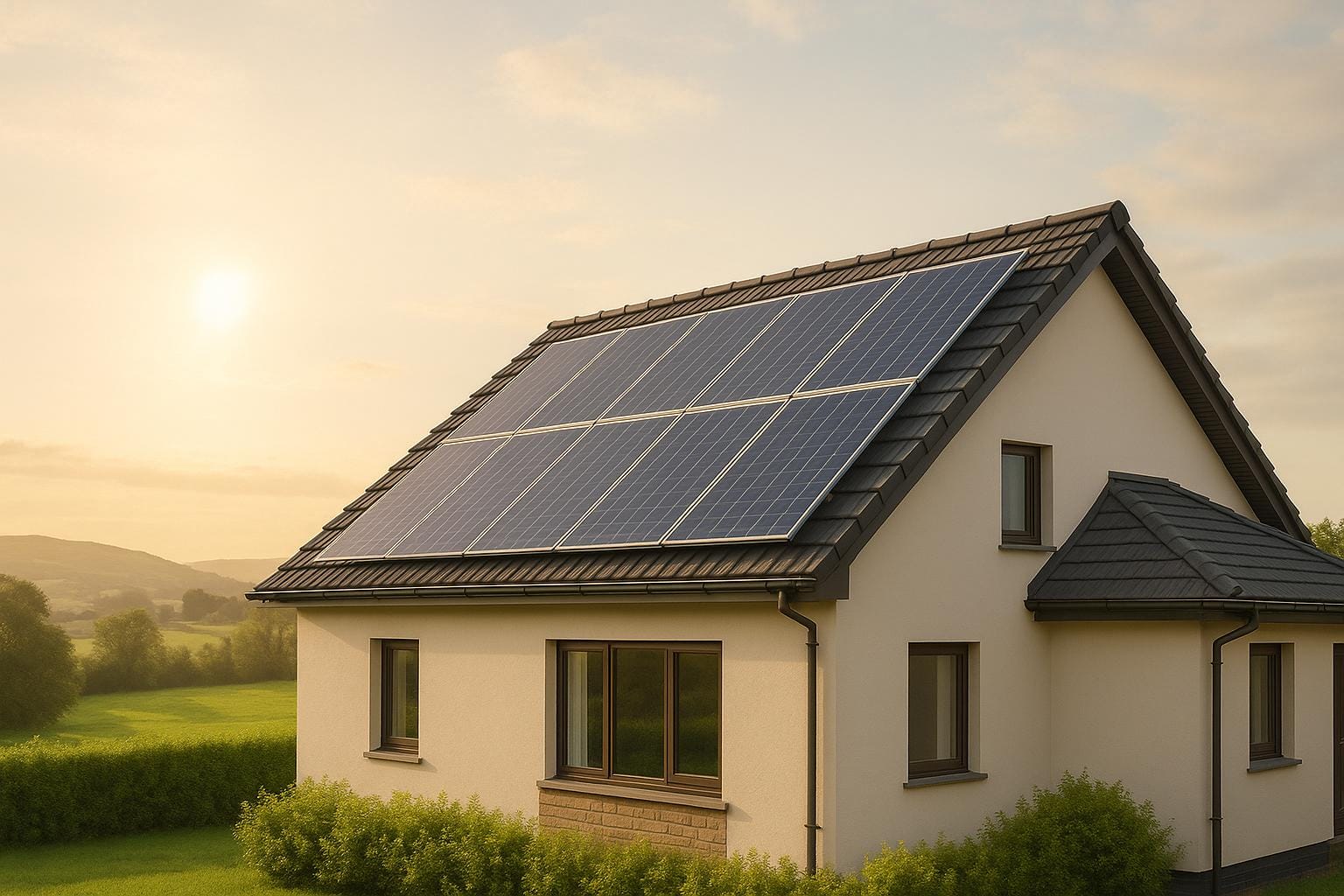The best fixed tilt angle for solar panels in Northern Ireland is 37.2°, balancing energy production across seasons. Seasonal adjustments can improve efficiency further: 22.2° in summer, 52.2° in winter, and 37.2° during spring and autumn. South-facing panels perform best, generating up to 12% more energy than east- or west-facing ones. Cooler weather in Northern Ireland helps maintain panel efficiency, even on cloudy days. Roof type, pitch (30–40°), and local conditions also affect performance. Fixed systems are simpler, while seasonal adjustments can boost energy output by 10–25% but may require additional effort and cost.
Key Points:
- Fixed Angle: 37.2° for year-round efficiency.
- Seasonal Adjustments: 22.2° (summer),Best Angle for Solar Panels in Northern Ireland
- Orientation: South-facing is ideal; southeast or southwest also work well.
- Weather: Panels remain efficient in cool, cloudy conditions.
- Installation: Roof pitch, direction, and mounting system are critical factors.
For most homes, fixed systems are cost-effective and reliable, while seasonal adjustments suit those prioritising maximum energy gains.
Best Year-Round Tilt Angles for Solar Panels
Here’s a closer look at the recommended tilt angles for solar panels in Northern Ireland, ensuring optimal energy production throughout the year.
Recommended Fixed Tilt Angle for Northern Ireland
For a hassle-free, year-round solar setup, the ideal fixed tilt angle in Northern Ireland is 37.2°. This angle strikes a balance between capturing sunlight during the longer summer days and the lower winter sun, making it an efficient choice without requiring seasonal adjustments.
Effective Tilt Angle Range
While 37.2° is the optimal angle, there’s no need to aim for absolute precision. Angles between 30° and 40° still deliver excellent energy output in Northern Ireland. Conveniently, most UK homes already have roof pitches within this range (25° to 40°), making it easier to align panels effectively. For those seeking a balanced compromise, 30° to 35° is a reliable range to consider.
How Fixed Angles Affect Energy Output
Opting for a fixed angle offers a practical, straightforward solution. A tilt of 37.2° ensures consistent energy production across seasons without requiring manual adjustments. During summer, when the sun is higher, the panels efficiently capture energy, while in winter, the steeper tilt compensates for the sun’s lower position, maintaining steady output during shorter days.
Fixed systems also bring additional benefits. They are simpler to install, as they don’t require adjustable mounts or seasonal recalibrations. This reduces installation costs and eliminates the need for ongoing maintenance, making the system more reliable and cost-effective. Additionally, the predictable energy output simplifies return-on-investment calculations, making fixed-tilt systems a dependable choice for Northern Ireland’s variable weather.
A quick comparison highlights the differences in tilt angles across regions:
| Region | Optimal Year-Round Tilt Angle |
|---|---|
| Northern Ireland | 37.2° |
| Scotland | 37.8° |
| North-East England | 37.2° |
| North-West England | 36.8° |
With these fixed angle recommendations in mind, it’s easier to evaluate whether seasonal adjustments might further enhance performance.
Seasonal Adjustments for Better Energy Efficiency
While keeping your solar panels at a fixed tilt of 37.2° offers steady performance, tweaking the angle seasonally can give your energy output a noticeable boost. Adjusting the tilt ensures your panels capture sunlight more effectively as the sun’s position changes throughout the year. Here’s a breakdown of how to optimise your panel angles for each season.
Seasonal Tilt Angle Guidelines
If you’re in Northern Ireland, these are the recommended tilt angles for maximum efficiency:
- Summer (June–August): Adjust your panels to 22.2° to align with the high summer sun. This shallower angle allows your panels to absorb more direct sunlight during the extended daylight hours.
- Winter (December–February): Increase the tilt to 52.2° to better catch the low-angled winter sun. This steeper angle helps offset the shorter days and lower sun trajectory.
- Spring and Autumn (March–May, September–November): A tilt of 37.2° works well during these transitional seasons.
As a general rule, subtract 15° from your latitude for summer and add 15° for winter.
Benefits and Practicality of Seasonal Adjustments
Seasonal adjustments can increase your solar energy output by 10–25% compared to a fixed tilt system. However, implementing these changes depends on the type of installation you have. Ground-mounted panels with adjustable frames make these modifications straightforward, while roof-mounted systems often require professional help.
It’s worth weighing the potential energy gains against the cost and effort involved. For many homeowners, the challenges of accessing roof-mounted panels and the associated safety concerns may outweigh the benefits of seasonal adjustments.
Fixed vs Seasonal Adjustments Comparison
Here’s a quick comparison to help you decide which approach suits your needs:
| Factor | Fixed Angle | Seasonal Adjustments |
|---|---|---|
| Initial Cost | Lower (standard mounting) | Higher (adjustable systems) |
| Energy Output | Consistent year-round | Potentially 10–25% higher |
| Maintenance | Minimal | Requires quarterly adjustments |
| Safety Considerations | No ongoing access needed | Regular roof access required |
| Practicality | Ideal for most homes | Best for ground-mounted systems |
| Long-term Reliability | High (fewer moving parts) | Moderate (adjustment mechanisms may wear) |
Lastly, keep your surroundings in mind. Adjusting your panels could unintentionally introduce shading from nearby trees or buildings, which can reduce efficiency. Always evaluate your site conditions before making changes.
Key Factors for Solar Panel Installation in Northern Ireland
Getting the most out of your solar panels involves more than just setting them up at the right angle. In Northern Ireland, specific conditions play a major role in determining how efficient and effective your system will be. By understanding these factors before installation, you can make informed choices that boost energy production and maximise your return on investment.
Roof Type, Pitch, and Direction
Your roof’s orientation and structure significantly influence how well your solar panels perform. South-facing roofs are ideal, generating up to 20% more energy than east- or west-facing ones. While east and west orientations are still viable, north-facing roofs struggle with poor sun exposure. If a north-facing roof is your only option, a ground-mounted system might be a better alternative.
As Briain Kelly, Editor of a renewable energy publication, explains:
"In Ireland, south facing solar panels will provide the most electricity throughout the day. This is because here in the Northern Hemisphere, the sun is to the south of us."
The perfect roof pitch for Northern Ireland falls between 30 and 40 degrees. This angle ensures your panels capture sunlight effectively. If your roof doesn’t meet this pitch, mounting systems can often adjust the panels to the right tilt.
Of course, roof orientation isn’t the only thing that matters. The local weather also plays a big part in determining how well your system performs.
How Local Weather Affects Solar Efficiency
Northern Ireland’s climate, with its frequent clouds and rain, presents both challenges and opportunities for solar energy. While cloudy days reduce direct sunlight, solar panels can still produce energy from diffused light. On overcast days, panels typically operate at 10–25% of their maximum capacity, with efficiency dropping by up to 50% under heavy cloud cover. Despite these conditions, the region’s annual sunshine of 1,100–1,600 hours means panels can still generate meaningful energy year-round.
Interestingly, cooler temperatures during the colder months can actually improve panel performance. As First Class Solar notes:
"While clouds reduce the amount of direct sunlight reaching the panels, they also prevent panels from overheating, helping to reduce any temperature-related efficiency losses."
Rain also plays a helpful role by naturally cleaning panels, removing dust and debris that could otherwise lower efficiency. To make the most of this, installing panels at an angle that allows rainwater to run off effectively is a smart move. Pairing this with high-quality panels and monitoring systems ensures consistent performance, even in challenging weather.
Custom Mounting Solutions
Roof characteristics and weather conditions are only part of the equation. The type of mounting system you choose also impacts how well your solar panels perform. Custom mounting solutions can optimise panel placement for any roof type.
For pitched roofs, mounting systems typically use hooks and rails attached to the roof rafters, ensuring stability and allowing for natural cooling. Flat roofs, on the other hand, require specialised setups. Ballasted systems, which use weights to secure panels without penetrating the roof, help maintain roof integrity while allowing for adjustable angles.
If roof space is limited or unsuitable, ground-mounted systems offer a flexible alternative. These systems are easier to maintain and can be positioned for maximum sunlight exposure, but they do require adequate garden space and may need planning permission. For properties with shaded or structurally unsound roofs, wall-mounted panels on south-facing walls can be an effective option.
Here’s a quick breakdown of mounting options:
| Mounting Type | Best For | Key Advantages | Considerations |
|---|---|---|---|
| Pitched Roof | Standard sloped roofs | Cost-effective, natural cooling | Limited by existing roof angle |
| Flat Roof Ballasted | Flat roofs, no penetration needed | No roof damage, adjustable angles | Requires structural load assessment |
| Ground Mount | Properties with garden space | Flexible placement, easy upkeep | Needs space, may require planning permission |
| Wall Mount | Shaded or unsuitable roofs | Alternative for limited options | Fewer mounting locations available |
Before choosing a mounting system, it’s essential to assess your roof’s load-bearing capacity – especially for ballasted flat roof systems – and check for shading from nearby objects that could reduce efficiency. Also, ensure your system is built to handle Northern Ireland’s weather, including strong winds and occasional storms.
sbb-itb-d2d975a
EECO Energy: Your Partner for Solar Solutions

Understanding the technical aspects of optimal solar panel angles is just the first step. To truly benefit from solar energy, expert installation is crucial. That’s why partnering with a team that knows Northern Ireland’s unique climate and energy needs can make all the difference. Enter EECO Energy – a company with over 25 years of experience installing solar systems across Northern Ireland.
Comprehensive Solar Energy Services
EECO Energy offers a wide range of services, including domestic and commercial solar installations, battery storage, off-grid systems, EV charging stations, solar thermal systems, efficient radiators, smart immersion controllers, and maintenance solutions.
As an approved installer of Duracell battery systems, EECO Energy can integrate reliable energy storage with your solar panels. This is particularly useful in Northern Ireland, where storing surplus energy generated during sunny spells allows you to use it later – on cloudy days or during the evening. Solar panel systems can cut electricity bills by over 90%, with typical monthly savings ranging from £50 to £180, depending on your system size and energy consumption. Over a system’s 25–30 year lifespan, these savings could amount to £15,000 to £25,000 or more.
Precision in Panel Placement and System Design
EECO Energy takes a tailored approach to solar panel placement, considering factors like roof exposure, orientation, and available space. Their team carefully evaluates your property to ensure your solar system delivers optimal performance, even on roofs with less-than-ideal orientations.
Their MCS registration guarantees that every installation meets stringent industry standards. From the start, EECO Energy provides a transparent breakdown of costs, savings, and timelines. Most systems are installed in just one day, causing minimal disruption. This attention to detail ensures your solar panels integrate seamlessly with your existing setup.
A happy customer, Lynsey, shared her experience:
"EECO Energy clearly explained the cost, expected savings, and outlined the entire installation process step by step. The installation was quick and efficient. We couldn’t be happier."
A Focus on Sustainability and Customer Care
EECO Energy’s commitment doesn’t stop at installation. They prioritise long-term results over quick fixes, ensuring your solar system is set up to perform efficiently for years to come. With a 25-year warranty and free surveys to assess your roof’s angle, orientation, and structure, they ensure your system is designed to maximise energy output while helping you reduce your carbon footprint.
Whether your goal is to lower energy bills, gain greater energy independence, or reduce environmental impact, EECO Energy’s approach ensures your system is tailored to thrive in Northern Ireland’s climate. By combining expert installation with precise technical know-how, they help you achieve significant energy savings. Their mix of high-quality components, technical expertise, and customer-first service makes them an excellent partner for your solar energy journey.
Conclusion: Getting the Most from Solar Panels in Northern Ireland
To make the most of your solar panels in Northern Ireland, it’s all about getting the details right – starting with the tilt angle and installation approach.
For year-round efficiency, a fixed tilt of 37.2° from horizontal is ideal. While seasonal adjustments can slightly boost output, sticking with this fixed angle keeps things simple and avoids the added cost and hassle of adjustable systems.
When it comes to orientation, south-facing panels are the gold standard for capturing sunlight. However, don’t worry if that’s not an option – panels facing southeast or southwest still deliver around 95% of the energy potential. Even north-facing panels can achieve about 60% of the optimal output, proving that solar power can work for a wide range of properties.
But here’s the key: the quality of your installation matters. A professional installer ensures your system is designed and mounted to maximise performance while adhering to all safety standards. This attention to detail is what turns a good setup into a great one, capable of handling Northern Ireland’s varying weather conditions.
FAQs
What is the ideal tilt angle for solar panels in Northern Ireland?
The best tilt angle for solar panels in Northern Ireland is around 37°. This angle aligns with the region’s latitude and the sun’s yearly path, ensuring the panels generate the most energy possible. It falls comfortably within the recommended range of 35-40°, providing steady performance throughout the year.
Setting your solar panels at this angle helps balance energy production between the summer and winter months, making the most of Northern Ireland’s distinct climate and daylight patterns. If you’re looking for expert advice on installation, EECO Energy can assist in fine-tuning your system to meet your specific requirements.
What is the best tilt angle for solar panels in Northern Ireland, and how does it vary by season?
The angle at which solar panels are tilted is key to optimising energy production, particularly in Northern Ireland’s distinctive climate. Adjusting the tilt according to the seasons can make a noticeable difference in how much energy your system generates.
During the summer months, when the sun sits higher in the sky, a tilt angle of 15–20 degrees works best to capture the most sunlight. In contrast, the winter sun is lower, so shifting to a steeper tilt of around 40–50 degrees allows the panels to align more effectively with the sun’s position. These seasonal adjustments help maximise energy collection and boost the overall performance of your solar setup.
If you’re looking for personalised advice or need assistance with your solar panel system, experts like EECO Energy offer tailored solutions to help homes and businesses across Northern Ireland achieve peak energy efficiency.
How can solar panels be installed effectively on roofs with less-than-ideal orientations in Northern Ireland?
When installing solar panels on roofs in Northern Ireland that don’t have the ideal orientation, it’s crucial to think about both the direction the panels face and their tilt angle to get the most energy possible. Ideally, panels should face south with a tilt of around 30–35 degrees. However, if your roof faces east or west, don’t worry – these orientations can still work well, especially if you tweak the tilt angle to capture more sunlight.
For flat roofs, you can use adjustable mounting systems to angle the panels towards the south or whichever direction gets the best sunlight. Even though non-ideal orientations might slightly lower the panels’ efficiency, carefully positioning them to account for seasonal changes in sunlight can still lead to substantial energy gains.


